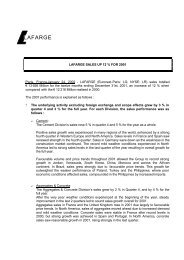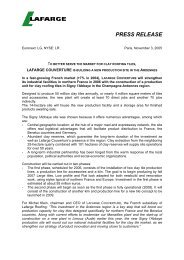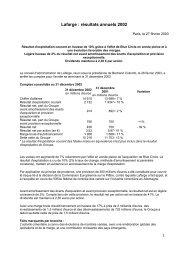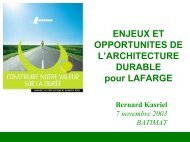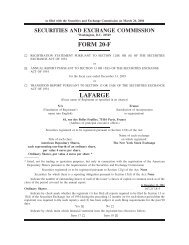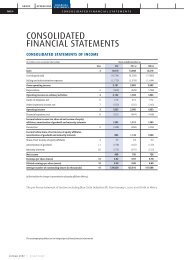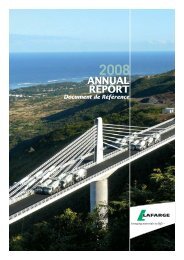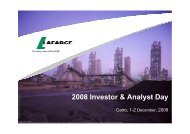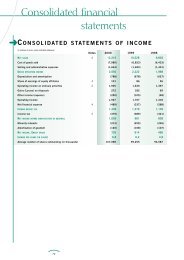You also want an ePaper? Increase the reach of your titles
YUMPU automatically turns print PDFs into web optimized ePapers that Google loves.
THE LINE OF EFFORT<br />
The module is formed by a panel<br />
whose design matches the distribution<br />
of effort in the structure.<br />
THE DESIGN<br />
The design produces optimal<br />
mechanics, which recalls the design<br />
of steel profiles.<br />
P.12<br />
“Ductal®, as a<br />
new material,<br />
challenges<br />
all the usual<br />
methods of<br />
calculation.”<br />
VILLA<br />
NAVARRA<br />
Heat expansion is by far the most difficult to predict. The<br />
highest expansion recorded due to variations in temperature<br />
can be as much as 5 mm and, when the calculations give a<br />
theoretically doubled value, as much as one centimetre. Ductal®,<br />
as a new material, challenges all the usual methods of calculation.<br />
The delicate lines made possible by the material mean that<br />
the engineer must ask himself all manner of questions never<br />
heard of with buildings in traditional concrete, particularly<br />
questions about expansion and twisting. “The calculations<br />
themselves are ordinary” says Mouloud Behloul, “but it’s the<br />
approach that is not, above all for concrete.” The thickness of<br />
the slab to resolve the problem of twisting has been measured<br />
at 35 mm, “a sheet of paper in terms of concrete!<br />
Originally designed for post-stressing, the panels would not<br />
have been very different, apart from necessarily being firmly<br />
anchored, as dictated by post-stressing. Entirely made of UHPFC<br />
Ductal® and reliant on this one type of material (except for the<br />
fixed reinforcing which was eventually placed in the ribs), the<br />
panels lie in a more traditional fashion on two longitudinal<br />
beams, placed 1.50 metre apart, forming a technical gallery.<br />
Supporting braces, made up of a rod inserted in a socket<br />
injected with resin and bolted at the surface with a wing nut<br />
holding in place a load spreading plate, are placed along the<br />
back beam. For the second beam, simple neoprene cushions<br />
form the support.<br />
PREFABRICATION<br />
The art of<br />
moulds<br />
and pouring<br />
This choice, apart from the experimentation with<br />
materials that it affords, corresponds to a conscious<br />
choice of building method. Rudy Ricciotti is enthusiastic<br />
about the combination of a high tech product, as represented<br />
by Ductal® and industrial prefabrication, with traditional<br />
fitting without the constraints of the sophisticated processes<br />
necessitated by pre-stressing. If the formulation of Ductal®<br />
belongs to the world of the very latest highly sophisticated<br />
technology, its use is gradually becoming less dependent on<br />
laboratory culture, becoming known for real operational performance<br />
on the bulding site. Traditional fitting gives this innovative<br />
product, the result of ten years of research, a shared and<br />
mass appeal, which finally allows one to foresee mass usage in<br />
the short term. This “schizophrenic” relationship between<br />
production and fitting fuels the architect’s hope of seeing this<br />
family of concretes quickly becoming a material used by masons.<br />
The first stage in the process, prefabrication, still relies<br />
on the experimental culture necessitated by the material.<br />
The theory is already tainted by empiricism, having benefited<br />
from the expertise of the precaster, namely the Bonna Sabla<br />
company, located near Montpellier, France. The production of<br />
the mould and the method of pouring are determining factors<br />
for the production of these parts with elaborate and complex<br />
shapes, which also have a finished surface. The technological<br />
requirements are satisfied by the metal moulds which are<br />
produced by an aeronautics industry supplier. “In this way, two<br />
different industrial worlds, which normally are not aware of<br />
each other, are brought together in the manufacturing process,”<br />
notes the architect.<br />
TECHNOLOGICAL REQUIREMENTS<br />
The manufacture of the metallic<br />
moulds was performed by a supplier<br />
from the aeronautical industry.<br />
P.13




